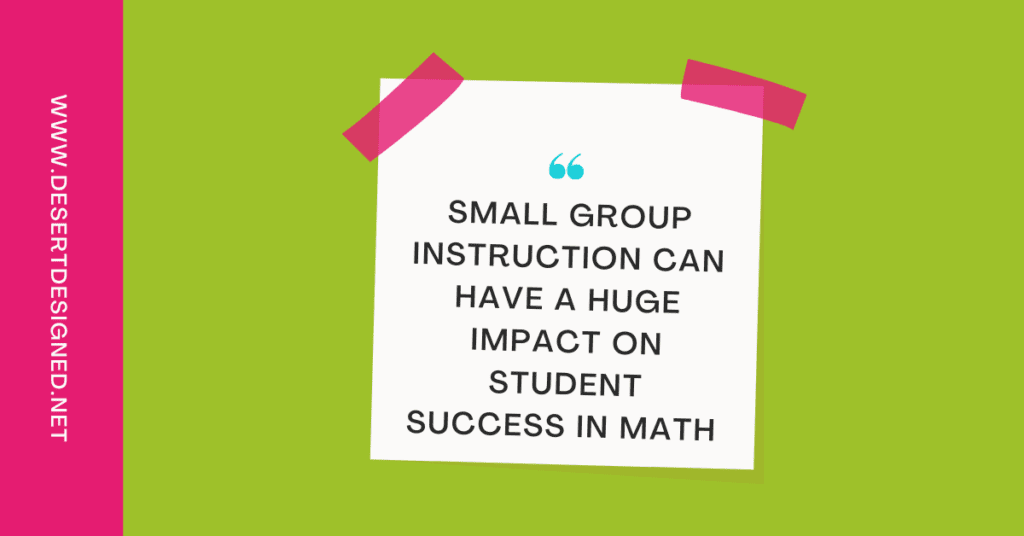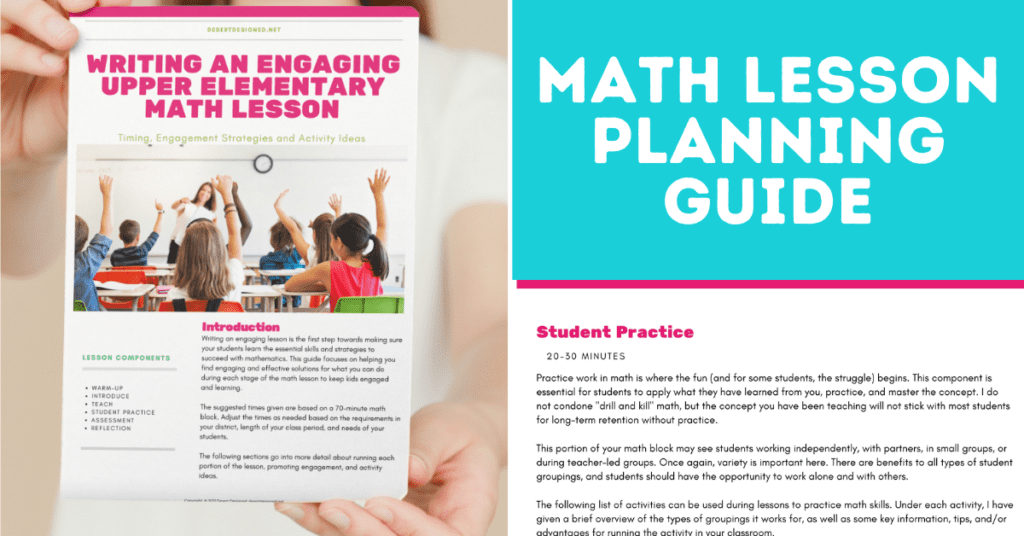
When I was a new teacher, I often struggled with how to group students for math lessons and practice. The options seemed endless and overwhelming. As teachers, we need to determine what size our groups should be and how to organize them.
Student grouping is just one of the many things to consider when creating engaging math lessons. To help you with all of the components of creating an engaging math lesson, check out our free guide!
How to Group Students for Math: Choosing Group Size
Math practice can be completed with the whole group, independently, or in small groups. Each group size comes with its own set of advantages and concerns, as shown below.
Whole Group
The whole group setting for math includes your entire class participating in the same activity simultaneously. Whole group instruction is typical during math instruction and less common for practice work.
Advantages of Whole Group
- Get an overall sense of the confidence and abilities of your class as a whole.
- Many students are very engaged by large-scale competition.
- During whole group is a great time to teach a new game, activity, or procedure that you would like the students to continue during small group or independent time.

Concerns with Whole Group
- Student engagement is challenging to maintain.
- Keeping track of which students may be struggling with the concept is troublesome.
- No time is available to assist individual students without breaking the flow of the practice activity.
Small-Group/Partners
Small groups in math typically consist of no more than six students. Small groups meeting with a teacher and up to six students can be successful. However, when students are working together without a teacher, six is typically unproductive. In this case, I prefer a group size no larger than four.

Advantages of Small Group or Partners
- Students can learn from and support each other
- Opportunity to check answers with a friend
- Creates engagement in social students
- Opportunity for the teacher to move from one group to another and interact with more students
Concerns with Small Group or Partners
- Choose your groupings carefully. It can be easy for some students to be a distraction for others
- Some students will mindlessly copy the answers of others
- Potential for off-task behavior
Independent Work
Independent work is when students are working alone. Assessments and some practice work are done independently. Some students struggle emotionally with groups and may prefer to work independently on a more regular basis, even when the rest of the class is working in groups.

Advantages of Independent Work
- Individual focus on skill
- Preferred by some students
- More accurate formative assessment of individual student skills
- Student self-assessment and correction
Concerns with Independent Work
- Struggling students may not progress with the concept
- More problematic for the teacher to address all students’ needs
- Limited opportunity for student discourse
How to Group Students for Math: Choosing Group Type
While group sizes are important, so are the types of groups. Read on to learn about the different types of groupings, their advantages, and implementation concerns.
Homogeneous Grouping
With homogeneous grouping, students work with other students of similar ability levels. To use homogeneous grouping, a teacher will look at formative and summative assessment data and group students with similar levels together.
In my classroom, I use formative assessment data to determine my homogenous groups. Check out this post about using formative assessment data wisely for more information.
Advantages of Homogenous Grouping
- Students can work with others of their ability levels.
- Great for enrichment. Advanced students can push one another further in a project when you use homogenous grouping.
- Helpful during interventions. As the teacher, grouping students with similar difficulties with a topic or skill can allow you to hone in on student struggles without leaving more advanced students bored.
- Activities can be differentiated by ability level for maximized student success and engagement.
- Creates chances for students who may think more slowly to get a chance to respond as opposed to when they work with higher students, and every answer is given before students get a chance to think it through.
Concerns with Homogenous Grouping
- Struggling students in homogenous grouping do not have as many peer role models if they struggle with a problem.
- It can be difficult to differentiate for lower students to work independently but still have access to grade-level content.
- Certain homogenous groups tend to struggle with on-task behaviors.

Heterogeneous Grouping
In heterogeneous grouping for math instruction, students are intentionally mixed by ability and skill levels. To create heterogeneous groups, teachers should look at their assessment data and group students based on their skill levels for the current topic.
Advantages of Heterogeneous Grouping
- Students can learn from one another, and proficient students can provide help to those who are struggling.
- Can build empathy in higher achieving students.
- Students can hear differing perspectives on how to approach a problem.
- Can improve students’ abilities to communicate the reasoning about the math they are completing.
Concerns with Heterogeneous Grouping
- Higher students may leave the struggling students behind and complete the work themselves rather than collaborating.
- Alternatively, lower and average students may sit back and let the higher-level students complete the work without jumping in to help.
- Some students feel frustrated after repeated heterogeneous groupings because they teach or tutor other students instead of improving their abilities.
Random Grouping
To create random groups, you can use a randomizing app, pull sticks out of a jar, or a numbering system to group students.
Advantages of Random Grouping
- Students have an opportunity to work with someone new.
- Can create a sense of anticipation or excitement as students wait to see their new groups.
- It does not take any pre-planning, so it is quick to implement.
Concerns with Random Grouping
- Students who have known behavior conflicts can sometimes end up in the same group.
- Some random groups can be heterogeneous, while others are homogeneous. Depending on the task, this could be problematic.
Student Choice Groups
I have two favorite ways to create groups based on student choice. I allow students to group themselves on the fly by asking kids to get into groups of a specific size. Alternatively, I have done pre-planned choice groups in the past as well. To do this, I ask students to submit a list of students they would like to work with or sit near. I then create the groups based on my knowledge of my students.
Advantages of Student Choice Groups
- Students enjoy working with their friends.
- Can increase productivity.
- Students feel comfortable working with the people in their group.
Concerns with Student Choice Groups
- It can bring up friendship issues when group size is limited, and students have to choose between their friends.
- This method can create stress and anxiety for more introverted students.
- Some friend groups do not work productively together.

Flexibility is the Key for How to Group Students for Math Successfully
There is a great deal to consider when thinking about grouping students for math instruction and practice. Try to be informed but not overwhelmed with the process.
Overall, I believe that variety is the key to keeping students engaged. Be sure to vary the groupings you use, either within the lesson or from one day to the next. This decision will come down to the time available, the personalities of your students, and the requirements of your school or district.
For more information about creating engaging math lessons, download our free guide for creating an engaging math lesson today!





